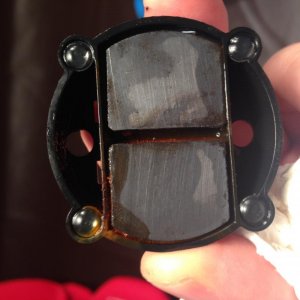As far as the magnets, two issues can cause this. The magnets themselves are ceramic and cannot rust, however they can pick up iron particles, including GFO which is just pelletized rust and this can lead to staining. I have also seen magnets brand new from the box with iron filings they picked up at the factory. In this case the staining can simply be cleaned off and provided the magnets do not pick up more particles the stain will not recur. Vinegar and CLR can both be used, CLR is much faster but thorough rinsing is required afterwards. The other cause can be that the magnets are bridged underneath by an iron plate. This plate is coated and should not rust (the black polyurethane edging around the magnets covers this plate and seals it). It is a plain iron plate, it is not plated in zinc or nickel and would create no toxic substances. If this is rusting due to a breach of the seal, their is a distinct difference in the appearance. When due to collected iron particles the appearance will be of flakes near the edges of the magnets. When due to a breach of the iron plate, the stain will have a distinct bullseye in the resin around the edges and the staining will be more heavy on the magnets themselves and have a pattern that is less wide spread and not confined to an edge where there is a rusting/flaking iron debris.
If the unit is properly assembled it should not easily separate and the lid should not lift upwards. One possibility would be that the pump is not in the proper position so the cord is in the way and preventing the two halves from fully closing, one of the plates can also do this if it is not lined up in the groove it should be in. The lid lifting could be related to this and may also be due to buoyant filter material lifting it up. I would be happy to have a look at it or try to walk you through solving these issues by emailing some pictures back and forth.

